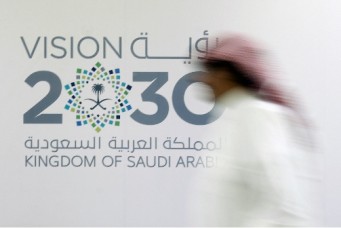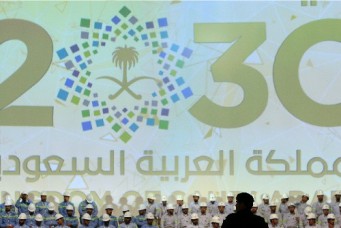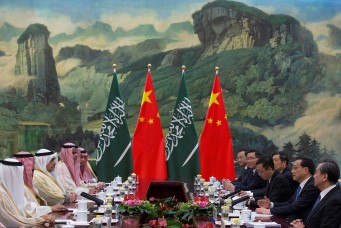Saudi Vision 2030: Winners and Losers
Saudi Arabia’s grand plan for economic reform might expand employment and transparency, but there would also be losers.
Saudi Vision 2030, designed and promoted by Deputy Crown Prince Mohammed Bin Salman, has been touted as the most comprehensive economic reform package in Saudi Arabia’s history. The document, released in April, is a neoliberal blueprint for privatizing entire sectors, raising non-oil revenues, cutting subsidies, courting investors at home and abroad, streamlining government services, and going public with the national oil company (Saudi Aramco), among hundreds of other initiatives. The hugely ambitious plan is partly a response to low oil prices. “We will not allow our country ever to be at the mercy of… commodity price volatility or external markets,” the deputy crown prince wrote in the foreword. It is also an effort to rationalize spending, breaking the kingdom’s historic cycle of providing more subsidies and services in “boom days” and cutting back when the state’s budget needed tightening. Although Prince Mohammed says the program is purely economic, if Saudi Vision 2030 is successfully implemented—and that is a big “if”—there will be winners and losers in Saudi society.
In particular, one of the key issues Saudi Vision 2030 aims to tackle is youth unemployment. The official but questionable unemployment rate is just shy of 12 percent, but that number will surge without intervention. Saudi Arabia faces a huge youth bulge (about 70 percent of the population is under 30), the oil-dependent public sector is expected to shrink in the coming years, and the private sector is underperforming due to excessive red tape and lack of investment. Saudi Vision 2030 plans to scale up less robust industries, especially those that can employ locals, through direct and foreign investment. The country’s sovereign wealth fund—the Public Investment Fund (PIF)—will lead this effort. The proposed transfer of Aramco shares to the PIF would make it the largest sovereign wealth fund in the world. (Prince Mohammed says it could be worth $2 trillion, although the real value will not be certain until Aramco goes partially public with its IPO.) This will allow the PIF to expand its domestic portfolio and development projects while still seeking profits abroad.
Diversifying the economy will depend in part on expanding Saudi Arabia’s manufacturing base. One ambitious goal is to manufacture 50 percent of all military gear and hardware—including sophisticated aircraft—inside the kingdom, whereas currently Saudi Arabia imports 98 percent of all its military needs. Likewise, though Saudi Arabia already has a sophisticated, successful petrochemical sector in terms of the variety and value of goods produced, more can be done to ensure those products are used at home. Producing more valuable finished goods such as specialty plastics—rather than exporting the component chemicals—could potentially employ more nationals.
Saudi Vision 2030 aims to privatize additional sectors, including healthcare and air travel. According to the December 2015 McKinsey study that to some extent informed the Saudi Vision project, only one of every three healthcare professionals in the Kingdom is currently a Saudi national. The retail sector, in which nationals represent just 20 percent of the workforce, is also a priority. Under Vision 2030, retailers can now for the first time be completely foreign-owned—and between increased outside investment and the existing quota system for foreign-owned businesses, the government believes this could create one million new retail jobs by 2020.
In addition to youth, Saudi Vision 2030 aims to further develop women as a labor source, describing women as a “great asset” to be developed educationally and professionally. The plan seeks to raise the percentage of women in the overall workforce from 22 percent to 30 percent by 2030. It calls for the government to hire more women while promoting telework options and providing reasonably priced transportation for women specifically. While ending the ban on women driving would save households money and make it easier for women to seek opportunities, such a change is not on the agenda yet, although it would align with the overall reform program.
Beyond such economic opportunities, Saudis stand to benefit from numerous reforms designed to make public services more responsive. Though a lack of transparency is a hallmark of the Saudi system, the reforms include new public accountability measures, such as regular internal audits of spending and tracking of ministerial achievements and failures. The National Transformation Program 2020 (NTP)—the newest five-year plan, approved by the cabinet on June 6 to advance the Saudi Vision program—promises a “public performance indicator dashboard.” Details are scarce, but the text suggests it will be a regularly updated online progress report, part of a concerted effort to expand e-government. The proposed digitization of state records could also speed up bureaucracy. The NTP promises shorter waits for permits, medical care, and judicial decisions, plus improved services like high-speed internet and pest control. At the ministry level, many such initiatives in the Saudi Vision 2030 are modest, sensible, and overdue.
Then there are the losers. Entrenched, wealthy interests will remain comfortable, but they will benefit much less from state largesse. The Ministry of Finance, which manages all tax collection, hopes to triple non-oil revenue in part by collecting new taxes on unspecified “luxury” goods (though income and basic goods like food will not be taxed). Wealthy Saudis will also be taxed on undeveloped urban land—which has been hoarded over the years by those waiting for a government buy-out or a huge developer contract—as authorities hope that land owners will part with land more easily once it costs money to simply keep it. That land might then be used for development projects that serve the public and might address the country’s severe shortage of affordable housing.
The multi-year plan to roll back subsidies starting this year, which could save tens of billions of dollars annually, is projected to affect wealthy Saudis more than the lower and middle classes. Prince Mohammed says that 70 to 80 percent of subsidies serve the rich—an estimate that echoes IMF literature on the subject. The plan stipulates that wealthier Saudis will pay significantly more on a per-unit basis for water and electricity, while those who consume less will pay less per unit. Everyone already pays more for gasoline after the price was raised 50 percent (back to its 1999-2007 rate) at the end of December. Riyadh further plans to assist middle and lower classes directly with targeted cash transfers, which will offset the higher costs of living that come with subsidy cuts.
Public sector employees also have reason to be anxious. By 2020, the Ministry of Civil Service is to shrink payroll by 20 percent—though some of that savings will come from privatizing sectors currently managed by the government. Saudi Vision 2030 and the more specific NTP also raise questions about the capacity of those officials tasked with reform. Both projects read like corporate action plans, emphasizing measurable and deliverable projects in a system unfamiliar to many Saudi officials. If these projects are to be judged by their results, incapable or ineffective bureaucrats will be subject to scrutiny or dismissed outright. The first casualty was Water and Electricity Minister Abdullah Al-Husayen, who was dismissed in April. Customers protested outrageously high water bills for which he blamed technical issues like poor metering, leaks, and billing errors; he then made matters worse with insensitive remarks. However, the primary cause appears to be the new and much higher water rate imposed in January. It is entirely possible the government underestimated what households were prepared to pay or how much they waste. The new rate is under review, and a new minister is now in charge. In multiple interviews, Prince Mohammed has tied Al-Husayen’s performance, specifically the “unsatisfactory” implementation of reform, to his dismissal.
Saudi Vision 2030 is a monumental experiment, not a simple checklist. A plan of this scope will be detoured and likely altered. It will test institutions, officials, and the public’s patience. But the alternative could be widespread unemployment and a hopelessly overstretched welfare state that breeds discontent. Today’s spending is certainly unsustainable. In 2015 alone, net foreign assets fell by $115 billion—most of it foreign currency reserves, which continued to fall throughout the first half of 2016 but remain above $500 billion. The rate of the drawdown prompted the IMF to warn in October that reserves could be exhausted within five years, assuming oil prices stay low and public spending is not curtailed.
To avoid painful austerity measures that would anger the masses, Riyadh is fine-tuning the kingdom’s social contract rather than renegotiating it. It intends to become more responsive to specific public needs but also less responsible for the economic well-being of citizens. The deputy crown prince’s own status as a winner or loser depends on whether or not the government can strike this balance.
This article is reprinted with permission from Sada. It can be accessed online here.
Matthew M. Reed is Vice President of Foreign Reports, Inc., a Washington-based consulting firm focused on oil and politics in the Middle East.
Subscribe to Our Newsletter






